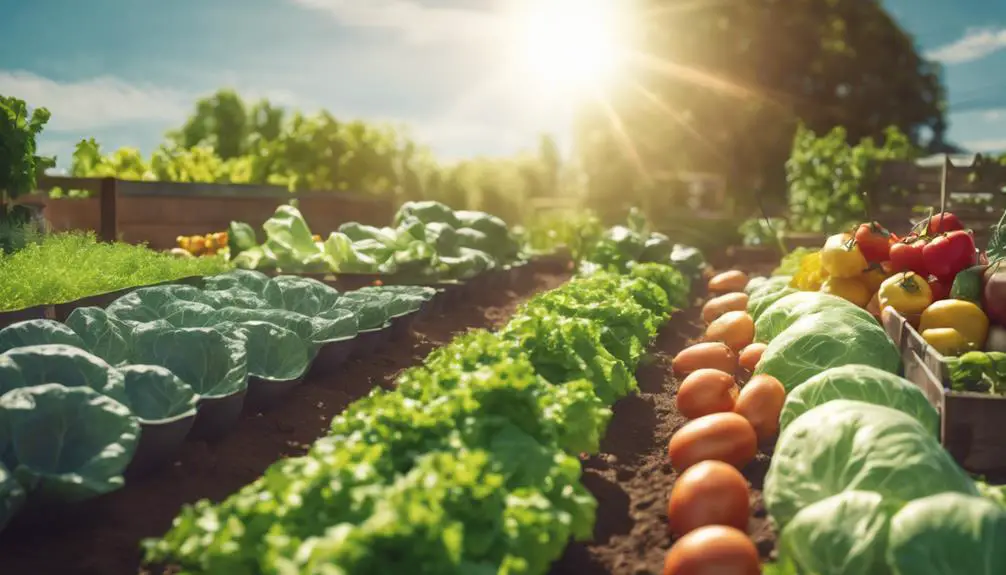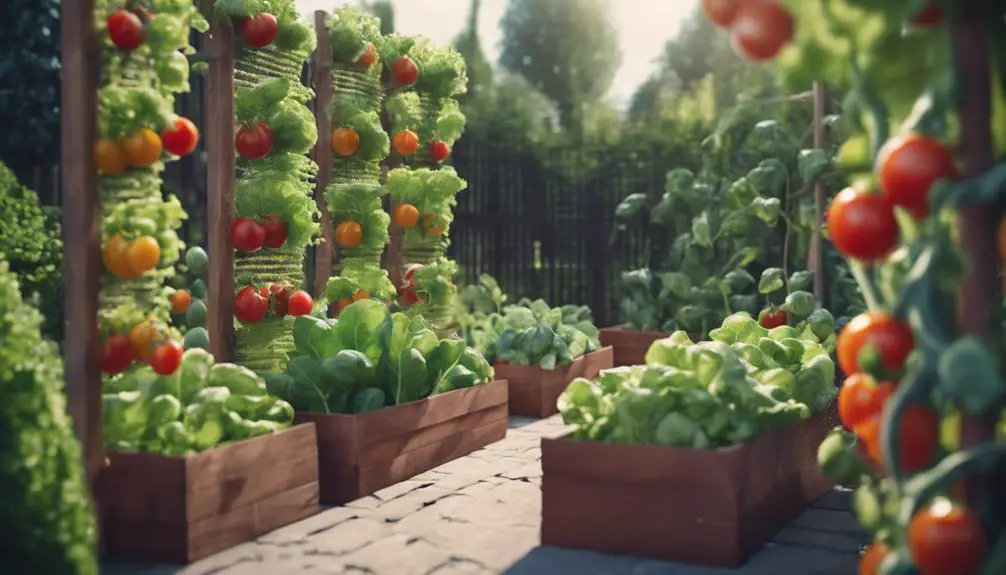As you begin designing your vegetable garden, you'll want to take stock of your yard's unique conditions. You're probably already thinking about the perfect spot, but have you considered the sun's path, shade patterns, and soil composition? By mapping your yard, you'll identify areas with favorable conditions for growth. Now, imagine selecting the vegetables you love, and planning a layout that guarantees a thriving harvest. But, how do you balance spatial relationships, crop rotation, and irrigation systems to create a truly successful garden? The answers to these questions will set you on the path to a bountiful harvest.
Assessing Your Yard's Conditions

One of the most critical steps in designing a thriving vegetable garden is evaluating your yard's conditions.
You'll need to conduct a thorough site survey to identify the strengths and weaknesses of your outdoor space. Begin by creating a yard map, which involves sketching the layout of your yard, including the location of existing plants, trees, and structures.
This visual representation will help you pinpoint areas that receive full sun, partial shade, or full shade. Take note of any slopes, drainage patterns, and wind direction.
Observe how the sunlight moves across your yard throughout the day, as this will impact the growth of your vegetables. Also, identify any potential obstacles, such as rocks, roots, or utility lines, that may hinder your garden's development.
Choosing the Right Location
As you analyze your yard map, consider the areas that receive the most favorable conditions for vegetable growth, and prioritize them when choosing the right location for your garden.
Garden orientation plays a vital role in this decision, as it affects the amount of sunlight your vegetables will receive. A north-south orientation is ideal, as it allows for maximum sunlight exposure and reduces shading from surrounding structures.
Microclimates effects within your yard should also be taken into account. These small, localized areas can have unique conditions that differ from the rest of your yard.
For example, areas near walls or fences may receive reflected heat, while low-lying areas may be prone to frost. Identifying these microclimates will help you select the perfect spot for your vegetable garden. By considering these factors, you can optimize your garden's location to promote healthy growth and maximize yields.
Understanding Sunlight Requirements

With your ideal garden location selected, now it's time to ponder the sunlight requirements for your vegetables.
Most vegetables need at least six hours of direct sunlight per day, but some can tolerate partial shade. Morning sun, which is gentler and less intense, is ideal for vegetables like lettuce, spinach, and herbs.
These plants thrive in the soft, warm light and can suffer from scorching in intense afternoon sun.
Afternoon shade, on the other hand, is essential for vegetables like tomatoes, peppers, and cucumbers.
These plants require intense sunlight to produce well, but can benefit from some shade during the hottest part of the day to prevent overheating.
Consider the mature size of your plants and their spacing to guarantee they receive the right amount of sunlight.
Also, take into account any obstacles, such as trees or buildings, that may cast shade on your garden.
Soil Type and Amendments Needed
You'll need to assess your soil's composition to determine its pH level, nutrient content, and structure.
A thorough analysis will reveal the ratio of sand, silt, and clay, helping you identify areas for improvement.
Soil Composition Analysis
Analyzing your soil's composition is a crucial step in designing a thriving vegetable garden, since it determines the nutrients and resources available to your crops.
To get accurate results, use soil testing kits that measure pH levels, nutrient content, and contaminants. These kits usually include a sampling tool, testing strips, and a guide to interpret the results.
Take multiple samples from different areas of your garden to guarantee a thorough analysis.
Visualize your soil's composition using soil mapping tools, which create a 3D model of your soil's structure and nutrient distribution.
This helps you identify areas with poor drainage, nutrient deficiencies, or excessive salt buildup. With this data, you can create a targeted plan to address these issues and optimize your soil's composition.
Optimal Ph Levels
Now that you've mapped your soil's composition, it's time to focus on ideal pH levels, a critical factor in plant growth.
pH levels range from 0 to 14, with 7 being neutral. Most vegetables thrive in slightly acidic to neutral soil, between 6.0 and 7.0. However, some acid-loving plants like blueberries and strawberries prefer a pH as low as 5.5.
On the other hand, some vegetables like asparagus and squash have alkaline tolerance and can grow in soil with a pH up to 8.0.
To achieve ideal pH levels, you may need to add amendments to your soil. For acidic soil, add lime to raise the pH. For alkaline soil, add elemental sulfur or peat moss to lower the pH.
Crucial to test your soil regularly to monitor its pH levels and make adjustments accordingly. Visual signs of pH imbalance include stunted growth, yellowing leaves, and poor fruit production.
Selecting the Right Vegetables

Crafting a thriving vegetable garden begins with selecting the right vegetables, a pivotal step that sets the stage for a bountiful harvest.
You'll want to ponder your personal vegetable preferences, choosing varieties that you and your family will enjoy eating. Think about the types of dishes you like to cook and the vegetables that feature prominently in those recipes.
Seasonal availability is another vital factor to ponder. Cool-season vegetables like broccoli, kale, and carrots thrive in the cooler temperatures of spring and fall, while warm-season vegetables like tomatoes, peppers, and eggplants love the heat of summer.
Make a list of the vegetables you want to grow and research their specific growing requirements, including light, water, and nutrient needs. This will help you create a diverse and thriving garden that meets your needs and provides a continuous harvest throughout the growing season.
Creating a Garden Layout
As you visualize your ideal vegetable garden, consider the spatial relationships between beds, pathways, and plants, certifying a harmonious and functional layout that accommodates your chosen vegetables' unique growing requirements.
Create a rough sketch or digital model to experiment with different arrangements. Divide your garden into zones based on vegetable themes, such as leafy greens, root vegetables, or vining plants. This will help you allocate space efficiently and create a visually appealing layout.
Winding garden paths can add visual interest and make maintenance easier. Consider using materials like wood chips, gravel, or stepping stones to define pathways.
Plan for adequate space between beds to accommodate tools, watering cans, and your own movement. Aim for a minimum of 2-3 feet between beds, depending on the mature size of your plants. Certify your layout allows for easy access to each bed, reducing the need for excessive bending or stretching.
Crop Rotation and Planning

Beyond the initial layout, a well-planned vegetable garden relies on strategic crop rotation and planning to guarantee a bountiful harvest.
Crop rotation involves rearranging the placement of vegetables each season to avoid depleting soil nutrients and promoting pests and diseases. You'll need to group vegetables into families, such as brassicas, solanums, and cucurbits, and rotate them accordingly.
To plan your crop rotation, create a crop map, which is a visual representation of your garden beds and the vegetables planted in each.
Update your crop map each season to confirm you're rotating your crops effectively. Seasonal planning is also vital, as different vegetables thrive in different seasons.
Divide your garden into cool-season and warm-season crops, and plan your planting schedule accordingly.
For example, plant cool-season crops like broccoli and kale in early spring, and warm-season crops like tomatoes and peppers in late spring.
Building Raised Beds or Containers
You'll need to decide on a bed frame option that suits your garden's style and functionality, whether it's a simple wooden frame, a recycled material, or a composite material.
When building your raised beds, consider the ideal soil depth for your vegetables, which typically ranges from 6 to 12 inches, depending on the root system of the plants you're growing. By choosing the right frame and soil depth, you'll create a well-structured foundation for your vegetable garden to thrive.
Bed Frame Options
When envisioning your ideal vegetable garden, the bed frame serves as the foundation, providing a defined growing space for your crops.
To create a well-structured raised bed, you'll need to choose a suitable frame material. Wooden borders are a popular choice, offering a natural aesthetic that blends seamlessly into the garden landscape.
They can be constructed from a variety of wood types, such as cedar, reclaimed wood, or pressure-treated lumber. Wooden frames can be built to varying heights, allowing for customizability to suit your specific needs.
Alternatively, metal edgings provide a sleek, modern look and are often more durable than their wooden counterparts.
Aluminum, steel, or recycled metal edgings can be used to create a clean, minimalist design. Metal frames are also easier to install and require minimal maintenance.
Consider the style and functionality you want to achieve in your garden when selecting a bed frame material. Both wooden and metal options have their advantages, so weigh your priorities to create a frame that complements your vegetable garden's overall design.
Soil Depth Considerations
With your bed frame in place, it's time to turn your attention to the soil depth considerations that will support the healthy growth of your vegetables.
When building raised beds or containers, you'll want to guarantee the soil is deep enough to accommodate the root systems of your plants. A general rule of thumb is to provide at least 6-8 inches of soil depth for most vegetables, but some, like carrots and potatoes, require more.
To determine the ideal soil depth for your specific plants, use soil mapping tools or consult with local nurseries and gardening experts.
Soil profiling kits can also help you analyze the structure and composition of your soil, allowing you to tailor your bed's design to meet the unique needs of your plants.
When calculating soil depth, don't forget to factor in the height of the bed frame and any drainage materials, like gravel or landscape fabric, that will occupy space.
Irrigation and Watering Systems

Proper irrigation and watering systems are essential to a thriving vegetable garden, as they guarantee consistent moisture levels and prevent waterlogged soil.
You'll want to ponder a drip irrigation system, which delivers water directly to the roots of your plants, reducing evaporation and runoff. This efficient method allows you to target specific areas, ensuring each plant receives the right amount of water.
To take it a step further, incorporate water timers into your system. These devices enable you to automate watering, ensuring your plants receive consistent moisture levels, even when you're not there to water them manually.
You can set timers to water your plants at specific intervals, taking into account factors like weather and soil type. By combining drip irrigation with water timers, you'll create a precise and efficient watering system that promotes healthy plant growth and minimizes waste.
With this setup, you'll be able to monitor and adjust your watering schedule with ease, giving you more time to focus on other aspects of your garden's design.
Companion Planting Strategies
As you plan your vegetable garden, you'll want to ponder the strategic placement of plants to maximize growth and minimize pests.
By planting for pest control, you can use certain vegetables to repel unwanted insects, while others will benefit from their neighbors' growth habits.
Planting for Pest Control
Get ready to outsmart pests by harnessing the power of strategic plant placement.
By incorporating pest repellent plants into your vegetable garden, you'll create a defense system that's both eco-friendly and effective. Planting certain species alongside your vegetables can deter pests from taking over, reducing the need for chemical pesticides.
Some of the most potent pest repellent plants include marigolds, basil, and nasturtiums.
These flowers release chemicals that repel nematodes, whiteflies, and aphids, creating a protective barrier around your crops. For example, planting marigolds around tomatoes can reduce nematode infestations by up to 90%.
Meanwhile, basil's pungent scent deters whiteflies and aphids from feasting on your prized vegetables.
Beneficial insects like ladybugs and lacewings also play a vital role in pest control.
By attracting these insects to your garden, you'll encourage them to prey on pests, providing an additional layer of protection.
Vegetable Friends and Foes
Your vegetable garden's success relies heavily on the harmonious coexistence of its inhabitants.
Companion planting strategies can either enhance or hinder vegetable synergy, ultimately affecting garden harmony. By selecting compatible vegetables, you create an ecosystem where each plant benefits from the others' strengths and weaknesses.
For instance, planting marigolds with tomatoes can deter nematodes, while basil repels pests that target tomatoes.
On the other hand, some vegetables can be detrimental to their neighbors.
Members of the Brassica family, such as broccoli and cauliflower, should be kept away from members of the Solanaceae family, like tomatoes and peppers, as they're susceptible to similar diseases.
Additionally, beans and onions shouldn't be planted together, as onions can stunt bean growth.
When designing your garden, group vegetables according to their growth habits, light requirements, and spatial needs.
Visualize how each plant will mature and allocate space accordingly.
Growing Healthy Neighbors
Growing Healthy Neighbors
By carefully selecting which vegetables to plant together, you can harness the power of companion planting to create a thriving garden ecosystem.
This approach fosters vegetable harmony, where each plant benefits from its neighbors, resulting in improved growth, health, and productivity. For instance, planting marigolds with tomatoes can deter nematodes, while basil repels pests that target tomatoes.
Similarly, the tall stalks of sunflowers provide shade for lettuce and other shade-loving vegetables.
To achieve garden synergy, consider the growth habits, light requirements, and space needs of each vegetable.
Plant tall vegetables like peas or beans near shorter ones like carrots or radishes to maximize space.
Intercrop fast-growing vegetables like lettuce or spinach between slower-growing ones like broccoli or cauliflower.
By thoughtfully combining vegetables, you'll create a diverse and resilient garden ecosystem that minimizes competition and promotes mutual benefit.
This strategic approach will yield a more abundant and healthy harvest, while reducing the need for pesticides and other chemicals.
Adding Support Structures Needed

As you lay out your vegetable garden, incorporating support structures becomes essential for plants that need a little extra help to thrive.
You'll need to provide a framework for climbing plants like peas, beans, and tomatoes to grow vertically, maximizing space and promoting healthy growth. Trellis systems are ideal for vining plants, offering a sturdy structure for them to twine around.
For plants that require more extensive support, cage frameworks are the way to go. These enclosures provide a 360-degree framework for plants to grow within, keeping them upright and stable.
When choosing a support structure, consider the mature size of the plant, its growth habits, and the weight of its produce. By incorporating the right support structures, you'll be able to grow a diverse range of vegetables, from sprawling cucumbers to towering sunflowers.
With a little planning and creativity, you can create a thriving and productive vegetable garden that's both functional and visually appealing.
Incorporating Aesthetics and Style
Crafting a visually appealing vegetable garden involves more than just selecting the right plants and support structures – it requires deliberate planning to incorporate aesthetics and style.
You'll want to balance functionality with visual harmony to create a space that's both productive and pleasing to the eye. Consider the color palette and texture of your plants, as well as the materials and finishes of your support structures and garden ornaments.
When choosing garden ornaments, select pieces that complement your garden's theme and style. For example, a modern garden might feature sleek, metallic accents, while a rustic garden might incorporate natural stone or reclaimed wood.
Don't be afraid to experiment with different shapes, sizes, and materials to add visual interest.
Frequently Asked Questions
How Often Should I Water My Vegetable Garden During Hot Summer Months?
During hot summer months, you'll want to water your vegetable garden deeply but infrequently to encourage deep root growth, conserving water through efficient summer watering techniques like drip irrigation and mulching.
Can I Grow Vegetables in a Garden With a Lot of Shade?
You can successfully grow shade-tolerant vegetables like lettuce, spinach, and kale in partial shade gardens, where they'll thrive under dappled light, but be aware that yields might be lower and growth rates slower compared to full-sun gardens.
Are There Any Vegetables That Don't Need to Be Rotated Every Season?
You'll find that fixed crops like asparagus, rhubarb, and artichokes thrive in permanent planting, allowing you to skip rotation and focus on nurturing their growth, while still reaping a bountiful harvest.
Can I Use Old Pallets to Create a Raised Bed for My Vegetables?
You can repurpose old pallets into a raised bed by disassembling them and arranging the pallet material in a sturdy, visually appealing pattern, ensuring proper drainage and aeration for your veggies to thrive in a unique, space-saving arrangement.
How Do I Keep Pests Like Slugs and Snails Out of My Vegetable Garden?
You'll effectively deter slugs and snails by installing slug barriers around your vegetable beds and applying copper tape, which reacts with their slime to repel them, creating a protected zone for your prized crops.
Conclusion
As you finalize your vegetable garden design, remember to balance functionality with visual appeal. Certify your layout is efficient, yet visually striking, with thoughtful companion planting and strategically placed support structures. With careful planning, your garden will thrive, providing a bountiful harvest and a serene oasis in your yard. By incorporating aesthetic elements, you'll create a space that nourishes both body and soul.




